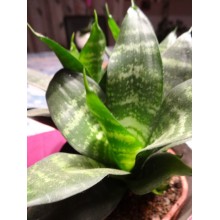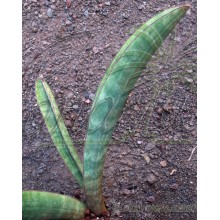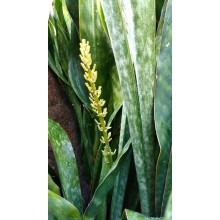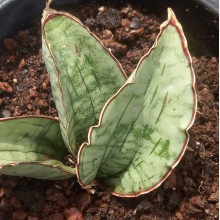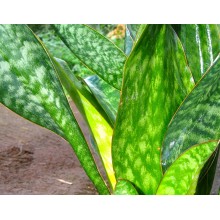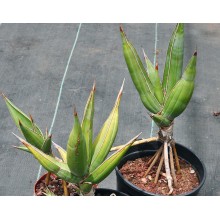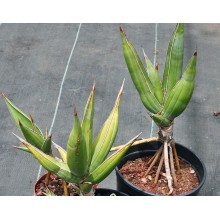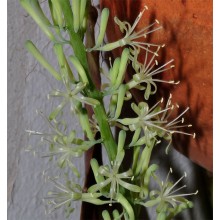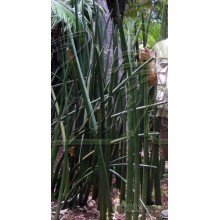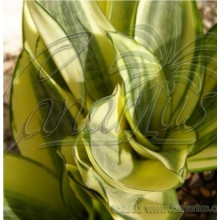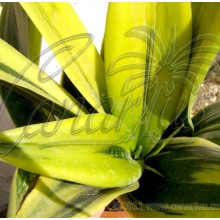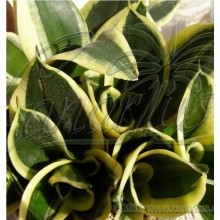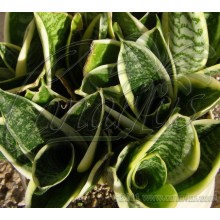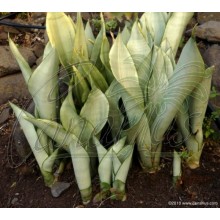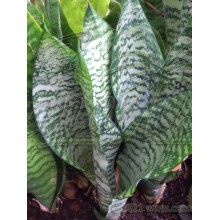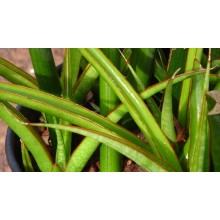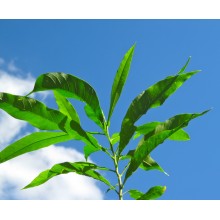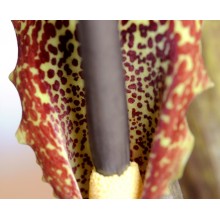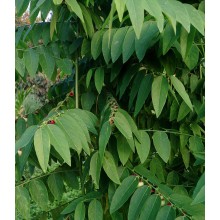Tutte le piante Ci sono 1882 prodotti.

Se vi piacciono le piante esotiche, allora sei nel posto giusto. Canarius offre le piante esotiche difficile da trovare che sono raramente disponibili in centri di giardinaggio. Il nostro negozio ha specie naturali e rari ibridi. Offriamo piante esotiche provenienti dalle Isole Canarie.
Gli ordini sono inviati a ovunque in Europa e anche in tutto il mondo. I pacchi raggiungeranno la vostra casa in pochi giorni dopo la spedizione (ma abbiamo bisogno anche alcuni giorni per l'elaborazione). Non esitate a contattarci se avete domande.
Sotto-categorie
-
Succulente
I deserti del mondo e le zone secche ospitano le piante più interessanti. Canarius offre una selezione crescente di piante succulente di massima qualità, perché sono coltivate all'aperto, in pieno sole delle Isole Canarie.
I succulente o "piante grasse" sono specie di ritenzione di acqua, adattate alle condizioni di asciutto. Loro accumulano succum (succo, acqua) nelle loro foglie, steli o radici, e spesso mostrano un aspetto robusto e carnoso.
-
Esotiche
Le piante esotiche sono specie provenienti da altre parti del mondo, e di solito hanno le qualità ornamentali: una vegetazione lussureggiante, fiori colorati, forme insolite... Qui è possibile trovare una grande varietà di piante esotiche: da bromeliacee e Heliconias, fino a palme e piante d'appartamento.
Le piante esotiche non hanno un uso particolare. I collettori acquistano questo tipo di piante per la loro rarità, per la decorazione interna o esterna, a seconda delle loro caratteristiche.
-
Da frutto & Per la salute
Le piante da frutto, erbe e piante medicinale sono concentrati su come ottenere una salute migliore. In questo contenuto della sezione, ogni tipo di pianta produce effetti salutari, entrambi alberi da frutto (Feijoa, Ananas, Fina Jete...) e piante per la salute, come Graviola, Aloe vera, Callisia fragrans... Nel normale metabolismo di tutti gli esseri viventi, l'organismo produce delle sostanze nutritive da latenti per l'ambiente; alcune di queste sostanze chimiche sono parte del processo in tutte le specie. Normalmente, i composti utili sono concentrati in alcune dei sue parti: foglie, semi, fiori...
-
Speciale
Su canarius.com cerchiamo di rimuovere i limiti nel campo della botanica. Sul nostro negozio online cerchiamo di facilitare l'acquisto / vendita di piante di tutto il mondo. Per questo motivo, coltiviamo piante di tutto il mondo, specie più comuni ed anche piante più particolari, come si può vedere in questa sezione.
-
Sansevieria hallii
Sansevieria hallii
Curious plant nicknamed “Baseball Bat” for the unusual look of its banded tubular leaves, growing from a short underground rhizome. It is easy, but very slow growing: a rare collector’splant.
28,00 € -
Sansevieria hyacinthoides
Sansevieria hyacinthoides
Big shoots, 50-60cm tall - Vigorous species, widely distributed in Central-Southern Africa. It has larger tall flat leaves, marked with pale green spots and a red margin. It likes shade and grows indoors. Traded in Africa as a medicinal plant.
12,80 € -
Sansevieria kirkii "Silver Blue"
Sansevieria kirkii "Silver Blue"
This exceedengly ornamental Sansevieria was collected in the Mbeya Province, in Tanzania and it has been grown for years as Sansevierias sp. Silver Blue.
27,30 € -
Sansevieria masoniana
Sansevieria masoniana
Elegant sansevieria with large wideerect mottled leaves. It is native to Zaire and was described in theyear 2000. Single or paired leaves rise from a thick, undergroundrhizome.
17,20 € -
Sansevieria parva
Sansevieria parva
NEW ! - Small rooted clump - "Parva" means "small"! Tiny stoloniferous species, eventually forming a carpet or filling ahanging basket. Native to cooler mountains of Rwanda, Uganda andKenya, it is probably the hardiest of the Sansevierias.
10,70 € -
Sansevieria pinguicula
Sansevieria pinguicula
Very diffent among sansevierias, this species has chubby leaves with a spine on the tip, and it grows on stolons, so it "walks" .We offer a well rooted plant of 24 cm height.
41,30 € -
Sansevieria pinguicula-Large-
Sansevieria pinguicula-Large-
Very diffent among sansevierias, this species has chubby leaves with a spine on the tip, and it grows on stolons, so it "walks" .We offer a well rooted plant of 24 cm height.
120,20 € -
Sansevieria roxburghiana
Sansevieria roxburghiana
Native to Southern and Eastern India, this Sansevieria grows to 40-80 cm in height. It is found on dry forested slopes, gravelly soil and rock crevices, less often in the plains, from rather low elevations up to 1000 m.
23,00 € -
Sansevieria stuckyi
Sansevieria stuckyi
A huge clump of Green Elephant Tusks: stiff, upright cylindrical leaves up to 2 m tall. This is an impressive species from Tropical East Africa. The largest of all sansevierias. It can grow indoors in a large pot, in bright light. We ship a 40-60 cm plant, bare-rooted.
16,30 € -
Sansevieria trifasciata cv Golden Hahnii
Sansevieria trifasciata cv Golden Hahnii
NEW ! - Cont. 8-10 cm. The most sought after of all the “Hahnii”. Thin, small, yellow, semi translucent leaves with a wide, central green band. Its ample variegation makes this plant the most delicate of the series: better grown indoor in a warm,
10,80 € -
Sansevieria trifasciata cv Goldflame
Sansevieria trifasciata cv Goldflame
NEW ! - 30 cm tall, cont. 12 cm. Wonderful, new cultivar showing a unique type of variegation:looks as painted with glossy creamy-golden enamel. It grows in ‘tulip shaped’ rosettes of thick, 30 cm long, arching leaves. The most brightly coloured.
10,80 € -
Sansevieria trifasciata cv Hahnii Jade Marginata
Sansevieria trifasciata cv Hahnii Jade Marginata
NEW ! - A “Hahnii” lacking any silvery spot or stripes. Miniature rosettes of dark green, glossy leaves. Uncommon, new addition to the Hahnii series.
10,80 € -
Sansevieria trifasciata cv Hahnii Marginata
Sansevieria trifasciata cv Hahnii Marginata
NEW ! - This ”Hahnii” has a thin yellow leaf margin. Rosettes are smaller and tighter than typical “Hahnii”. It thrives in partial shade, keep warm and dry in winter.
10,50 € -
Sansevieria trifasciata cv Moonshine
Sansevieria trifasciata cv Moonshine
20 cm cutting, with stem - Moonshine, also called "Moonglow", is a recent cultivar. Leaves are almost white! As most sansevierias, it is suitable as a house plant indoors. This one is a bit slower than normal.
10,80 € -
Sansevieria trifasciata cv Robusta
Sansevieria trifasciata cv Robusta
NEW ! - An old classic in sansevierias, withmid-sized, glossy leaves with a green and grey banded pattern.An old classic in sansevierias, with mid-sized, glossy leaves with agreen and grey banded pattern.
10,90 € -
Sansevieria x 'Midnight Fountain'
Sansevieria x 'Midnight Fountain'
This sansevieria is slender, as a "fountain!", with very dark blue-green leaves with a red edge.
16,40 € -
Sapindus saponaria - Albero del Sapone
Sapindus saponaria - Albero del Sapone
The Soap Tree, Soapberry or 'jaboncillo' is is a tree native to the Americas and some Pacific Islands. The fruit occur in large pyramidal clusters at the ends of branches and it is very soapy. You can actually wash your hands by simply rubbing the fruits! It is very easy to grow, also in pots, and can easily take short, light frost so it is suitable for...
43,20 € -
Sauromatum venosum - Voodoo Lily
Sauromatum venosum - Voodoo Lily
Unusual cold-hardy Aroid with ornamental and weird inflorescences, up to 60 cm tall. Sauromatum venosum is summer growing and it rests in winter as an underground corm. In spring it wakes up showing a leopard-spotted spathe with a long dark spadix and for a few days they will produce a disgusting stink.
18,60 € -
Sauropus androgynus
Sauropus androgynus
Sauropus is a S.E. Asian perennial vegetable, which is very widespread in the home gardens of tropical Asia. Leaves are tasty and often eaten cooked, even though the younger leaves can be eaten raw and their taste is reminiscent of fresh peas.
34,00 €
Al momento ci sono pochi prodotti in questa categoria Tutte le piante




















